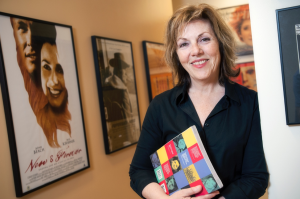Dr. Christine Ramsay completed her Honours BA in Film Studies at Carleton University and her MA and Ph.D. in Social and Political Thought at York University (Toronto). Her teaching and research are in the areas of Canadian and Saskatchewan cinemas, curating expanded cinema in Canada, masculinities in film and popular culture, cultural studies, philosophies of identity, and the culture of small cities. She recently co-edited Overlooking Saskatchewan: Minding the Gap University of Regina Press, 2014) with Randal Rogers. In 2012 she was Visiting Scholar at the graduate program in Canadian Studies, University of Edinburgh, where she developed her current book project, David Cronenberg and the Double. She serves on the editorial boards of Topia: Canadian Journal of Cultural Studies and Imaginations: Journal of Cross-Cultural Image Studies; and on the board of the Art Gallery of Regina. She is a past President of the Film Studies Association of Canada, past Chair of the Regina Arts Commission, a past Board Member of Regina’s Creative City Centre, and she hosted Prairie Night at the Movies on SCN. She is currently co-curating an exhibition on renowned Canadian-Armenian art filmmaker Atom Egoyan with the MacKenzie Art Gallery and Strandline Curatorial Collective, and a related Regina-based durational exhibition, Meet in the Middle: Stations of Migration and Memory Between Art and Film (2014-2016). MITM stages a unique Regina meeting ground for citizens affected by questions of the contemporary movement of people and ideas, and for artists and curators working through those questions at the nexus between art and film in their creative research and practice. MITM is a durational series of events taking place in Regina from Spring 2014 to Fall 2016. Conceived collaboratively as a succession of eleven way stations connected by common concerns underlying global migration and unfolding over two years, the project enables artists, audiences and researchers to stopover, encounter, intersect, reflect, locate and relocate themselves relative to the experiences and memories of diverse flows of people recalled and documented, imagined and represented, through the art/film practices of expanded cinema. Inspired by a recent influx of national and international immigrants to Saskatchewan and its postsecondary institutions, MITM arises from the City of Regina, Saskatchewan’s capital, an area inhabiting both the margins and centre of Canadian consciousness. Located on the Canadian plains at great distances from other major cities, the place nevertheless claims an important history of transformational undercurrents in art and film (the first Arts Board in North America; the first art gallery in a public library, the Dunlop, which became an important international model for public access to the arts; the Yorkton Film Festival, sister to Cannes and Edinburgh, and the longest running documentary festival in North America). Today Regina continues to innovate in new media exhibition methodologies and display, and enjoys a growing festival scene, including Indigenous perspectives through the Sâkêwêwak Artists’ Collective and the Mispon Film Festival. In Regina, the legacy of art and film are powerful forms for the continuing exploration of belonging, particularly as Indigenous people move between rural and urban areas, and new immigration patterns further diversify the cultural dynamics of the city. There are several organizations in Regina currently working collaboratively across art and film, the white cube and the black box, the analog and digital divide, the gallery and site specificity to take their place in the contemporary global landscapes of expanded cinema and create a place for local, national, and international artists, curators and audiences to come together to “meet in the middle.” The team’s primary objective is to create a new body of applied research in curating art/film and expanded cinema between the University of Regina, the MacKenzie Art Gallery, Regina’s Strandline Curatorial Collective, and local arts organizations—one with translocal and transnational scope, relevance and impact. HRI CR Film Studies at Carleton University offered a program that put the humanities on the map for me through the power of cinema. With Film Studies as my window, I was able to see and think across disciplines. National Cinemas, Film History, Women and Film, Masculinities in Contemporary Film, Documentary, Cinema and the City, Film Noir were some of my favourite courses for their ability to contextualize important issues for us as human beings and make visible the way we live our lives–issues such as personal identities; cultural identities; social and political issues; and the simple living of everyday life. HRI CR HRI CR HRI CR HRI CR HRI CR
 Dr. Christine Ramsey
Dr. Christine RamseyProject: Meet in the Middle I Stations of Migration and Memory Between Art and Film (2014-1016) (MITM)
Conversation
What motivated or sparked you to become a humanities researcher/scholar?
How did you come to your research focus/disciplinary specialization?
I was inspired to study film by a truly inspirational professor who taught the introductory course to Film Studies, at Carleton University. I was a mature student returning to university and looking for a summer course to ease into being back in school in the fall term, and a friend advised me to try Film 100 because of the professor teaching it. My mother and I had always been movie buffs together, watching double and sometimes triple bills on Saturday nights and late into Sunday mornings. But I didn’t know you could actually study it at university. It’s a cliché (but clichés are often true, that’s why we use them): The scales literally fell from my eyes as I learned a new vocabulary and way of thinking about film, not merely as entertainment, but as an aesthetic, social and cultural artefact of deep significance to understanding people and our worlds.
What future plans do you have for your research and its direction?
I currently have five programs of research: Masculinities in Canadian Cinemas; Saskatchewan Film Histories; Curating Expanded Cinema in Canada; The Culture of Small Cities; and a painting practice.
Which humanities scholar or creative practitioner inspires you and why?
I am very interested in questions of identity, psychology and the dynamics of dreams and the unconscious, so I admire very much the writings of scholars such as Mikhail Bakhtin, Jessica Benjamin, Walter Benjamin, Carl Jung and Michael Taussig; and the work of artists and filmmakers such as Janet Cardiff, David Cronenberg, Atom Egoyan, Lucian Freud and William Kentridge, among many others. And multidisciplinary artist Laurie Anderson has just released a brilliant little film that I highly recommend: Heart of a Dog.
What are two things about your humanities research that make them relevant to other researchers, scholars or students? To the broader public?
My research in the culture of small cities, with collaborators Marian Donnelly and Dr. Kathleen Irwin, has resulted in the development of Regina’s Creative City Centre, an entrepreneurial artists’ hub that is helping to revitalize the city’s downtown through the power of the arts and culture. My current work with the curatorial project Meet in the Middle: Stations of Migration and Memory Between Art and Film–a durational series of exhibitions, screenings and exchanges linked by the theme of trauma underlying contemporary experiences of migration and its memorialization–is taking place in Regina between 2014 and 2016. The project is a collaboration with Elizabeth Matheson (Strandline Curatorial Collective), Timothy Long (MacKenzie Art Gallery) and Rachelle Viader Knowles (Coventry University) designed to connect the work of artists and filmmakers variously dealing with this theme at the intersection between art and film, with a special focus on Regina, Saskatchewan; Coventry UK; and Gyumri, Armenia. MITM has forged important transnational connections for students and researchers in these cities–all of which have suffered traumatic histories of colonialism, war and genocide–to work together towards shared creative futures.
If you had one piece of advice for those wishing to pursue the humanities what would it be?
Walk to school. Walk to work. You feel more human.
Profiles: Humanities Research Fellow, Dr. Christine Ramsay was last modified: January 21st, 2017 by
Categories:
